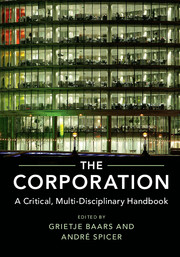Book contents
- Frontmatter
- Contents
- List of Contributors
- Acknowledgements
- Introduction: Why the Corporation?
- PART I DISCIPLINARY OVERVIEWS
- 1 The Corporation in History
- 2 The Corporation in Legal Studies
- 3 The Corporation in Economics
- 4 The Corporation in Sociology
- 5 The Corporation in Anthropology
- 6 The Corporation in Political Science
- 7 The Corporation in Geography
- 8 The Corporation in Accounting
- 9 The Corporation in Management Studies
- PART II INTERDISCIPLINARY THEMATIC CHAPTERS
- 1 The Evolution of the Corporate Form
- 2 The Multinational Corporate Group
- 3 The Financialization of the Corporation
- 4 Corporate Value Chains
- 5 Corporate Citizenship
- 6 The Corporation and Crime
- 7 The Corporation and Ideology
- 8 Corporation and Communities
- 9 Corporations and Resistance
- 10 Alternatives to the Corporation
- Index
- References
3 - The Corporation in Economics
from PART I - DISCIPLINARY OVERVIEWS
Published online by Cambridge University Press: 31 March 2017
- Frontmatter
- Contents
- List of Contributors
- Acknowledgements
- Introduction: Why the Corporation?
- PART I DISCIPLINARY OVERVIEWS
- 1 The Corporation in History
- 2 The Corporation in Legal Studies
- 3 The Corporation in Economics
- 4 The Corporation in Sociology
- 5 The Corporation in Anthropology
- 6 The Corporation in Political Science
- 7 The Corporation in Geography
- 8 The Corporation in Accounting
- 9 The Corporation in Management Studies
- PART II INTERDISCIPLINARY THEMATIC CHAPTERS
- 1 The Evolution of the Corporate Form
- 2 The Multinational Corporate Group
- 3 The Financialization of the Corporation
- 4 Corporate Value Chains
- 5 Corporate Citizenship
- 6 The Corporation and Crime
- 7 The Corporation and Ideology
- 8 Corporation and Communities
- 9 Corporations and Resistance
- 10 Alternatives to the Corporation
- Index
- References
Summary
The Modern Corporation and Market Competition
As with most other advanced economies, large corporations dominate the US economy. In 2012 (the latest complete data available), 1909 firms with 5000 or more employees were 0.033 per cent of all firms in the US economy but had 11 per cent of all establishments and employed 34 per cent of all employees in the business sector of the US economy while accounting for 38 per cent of payrolls and 44 per cent of sales revenues (United States Census Bureau, 2015). In 2014, the 500 largest publicly listed US companies by revenues (the Fortune 500) had a combined $12.5 trillion in revenues, $945 billion in profits, and 26.8 million employees worldwide.
The centrality of the large corporation to the advanced economies is nothing new. A century ago, it had already attained a dominant position across a range of industries in the richest economies of the United States and Europe (Chandler, 1990). Economists have had plenty of time to figure out how to incorporate the corporation into their thinking about how a modern economy operates and performs. As we shall see in this chapter, however, the neoclassical economists whose perspective dominates economic thinking have done a terrible job of it. In adhering to the idea that in an advanced economy the corporation can be construed as a ‘market imperfection’, the well-trained neoclassical economist reveals his or her ignorance about the operation and performance of the modern business corporation, and the modern economy to which it is central.
Conventionally trained economists, as almost all PhD economists are, see markets, not organizations, as the arbiters of resource allocation in the economy. As the benchmark of superior economic efficiency, they hold to the ideal of the ‘perfect market’ – one in which, because of easy entry by firms in an industry, there are so many firms competing in the industry that no single firm's output decisions can have a discernible impact on the price of the product it sells. Most economists recognize that ‘perfect competition’ is hard to find in the actual economy. Nevertheless, from their market-oriented perspective, ‘perfect competition’ represents the ideal for the economy's efficient allocation of resources against which one can evaluate various states of ‘imperfect competition’.
- Type
- Chapter
- Information
- The CorporationA Critical, Multi-Disciplinary Handbook, pp. 64 - 96Publisher: Cambridge University PressPrint publication year: 2017



